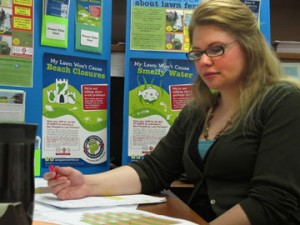By Renee Rodgers
 [1]
[1]TRENTON, On. (10/05/11) Kelsey Jensen recently headed up a door-to-door campaign in Belleville to promote awareness of the problems phosphorous runoff can cause to the Bay of Quinte.
Belleville residents are aware that using fertilizers on their lawn could be damaging the Bay of Quinte – just don’t ask them to sign a pledge to stop the practice.
Nine Loyalist College students took to the streets of Belleville the last week in April to conduct a door-to-door survey to promote awareness of the dangers of phosphorous, an ingredient found in many lawn fertilizers, to the bay and other bodies of water.
Participants were also asked to sign a pledge agreeing to eliminate the use of phosphorous on their lawns and gardens.
Project Coordinator Kelsey Jensen said many people made verbal pledges to reduce their use of phosphorous but most were unwilling to sign a pledge.
Jensen said making a written pledge shows a stronger commitment.
“If they do make a pledge, and especially if they sign a pledge, the message will stay with them longer and they’ll feel more committed to the cause,” she said. “Most people were really hesitant to write their name on anything.”
Jensen said she didn’t know why residents refused to sign pledges.
The survey was conducted as part of the Bay of Quinte Remedial Action Plan. According to its website, the BQRAP came about as an endeavour to improve the condition of the bay after it was named an Area of Concern by a great-lakes watchdog organization in 1985. At that time it was recognized that phosphorous runoff was contributing to excess algae in the Bay.
Sarah Midlane-Jones, a spokesperson for the Remedial Action Plan, said phosphorous, often found in fertilizers, can eventually make its way into major bodies of water such as the Bay of Quinte.
“People have a tendency to sort of throw it on the lawn and it gets on the driveway and then it rains and goes down the storm sewers and out into the nearest water source,” she said.
The process, called eutrophication, causes problems when the phosphorous acts as a fertilizer for algae, allowing it to grow at excessive levels. The large amount of algae causes a foul-smelling odour and uses up oxygen fish and other creatures need to survive.
Midlane-Jones said she wasn’t discouraged that only six people signed a written pledge. She said she was glad to see the survey results indicated Belleville residents were aware of the problem.
“It was very gratifying to find out how much awareness there was,” she said. “The Remedial Action Plan has been working away for the past little while on all these sorts of issues so when people say, ‘Yes, we know about it,’ it’s like, ‘Perfect!’.”
Stacy Ash is the owner of Pro Tackle Musky Shop in Belleville. An avid fisher, he said he’s seen his share of algae on the Bay of Quinte.
“When the water gets around 80 degrees (Fahrenheit) and it’s really hot, it gets dirty,” he said.
He also said he’s noticed more algae in the Bay of Quinte than other bodies of water.
“You go to Lake Ontario, Thousand Islands, the water is clear. You can see down 35 feet. In the Bay of Quinte, you can see three or four feet and that’s about it.”
Ash said algae can take different forms.
“You’ve got the type that looks like pollen on the surface of the water,” Ash said. “The water will have fine green particles. The other kind of algae would be your slime and that’s the stuff that’s gross. It sticks to everything. We don’t get a ton of it out there [on the bay]. It basically grows around plants. It’s usually in a greenish colour, of course. But a lot of the algae you see on the Bay of Quinte is usually the floating particles.”
While phosphorous runoff has contributed to high algae levels in the bay, the good news is fertilizing lawns with phosphorous usually isn’t necessary.
“Most lawns in Belleville don’t actually need phosphorous because they’re already established lawns, so to further promote that new root growth isn’t as necessary,” Jensen said. “Unless you’re laying new sod or new seed you typically won’t need phosphorous.”
Jensen said it’s easy to tell if a fertilizer contains phosphorous by looking at the set of three numbers listed on the bag. The first number represents the amount of nitrogen and the third number represents potassium. The middle number represents phosphorous.
“That number should be zero,” Jensen said.
Jensen gave some suggestions of other ways people can reduce the amount of phosphorous in the Bay of Quinte. First, plant trees.
“Trees help to take up the phosphorous from the soil and the water so that it doesn’t run off into the Bay,” said Jensen.
Also, avoid washing vehicles on the lawn. While the amount of phosphorous used in household detergents has been significantly reduced in recent years, it still does exist in smaller amounts. Phosphorous in soap can sink in to the soil and eventually find its way into the water.
Another thing residents can do is limit the amount of water they use when watering their lawns.
“The more water that is used, the more runoff will occur,” Jensen said.
Finally, members of the community can promote awareness by telling people about the harmful effects of phosphorous.
“Share this information with friends and your colleagues and your families,” Jensen said. “Get the message out.”
Clarification: This is a revised version of this story. Due to an editor’s error, the original story incorrectly said residents were hesitant to sign a pledge to stop using fertilizer on their lawns. It should have read they were hesitant to sign a pledge to stop using fertilizer containing phosphorous on their lawn.